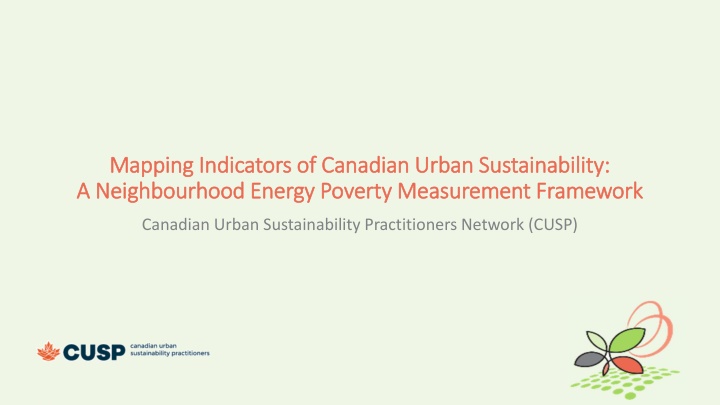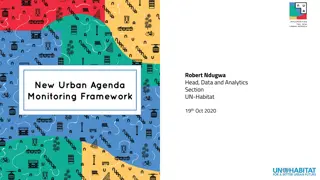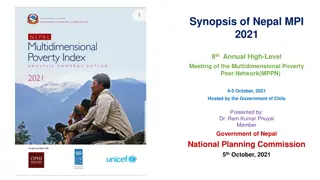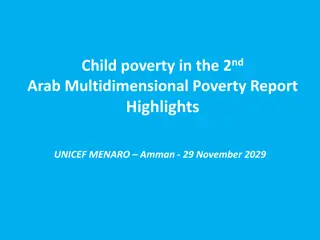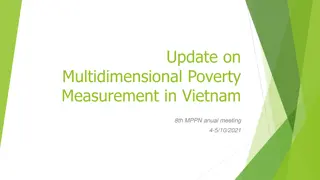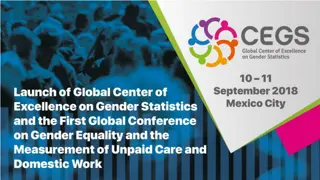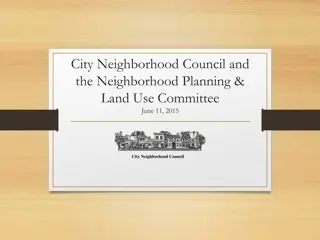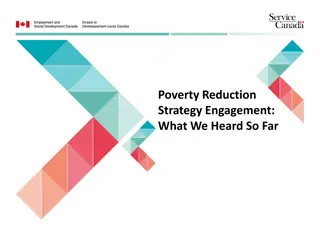Mapping Indicators of Canadian Urban Sustainability: A Framework for Neighborhood Energy Poverty Measurement
The Canadian Urban Sustainability Practitioners Network (CUSP) is implementing a project to reduce energy poverty through local clean energy access programs. The project aims to achieve energy and emissions goals, transition to clean energy, and benefit low/moderate-income households. By utilizing a data access tool, monitoring indicators of home energy cost burden, and promoting equity in clean energy programs, CUSP seeks to support underserved groups and improve outcomes for communities. The measurement framework utilizes data from the 2016 Census to analyze household energy expenditures and demographic characteristics, providing insights for municipal policy and program design.
Download Presentation

Please find below an Image/Link to download the presentation.
The content on the website is provided AS IS for your information and personal use only. It may not be sold, licensed, or shared on other websites without obtaining consent from the author.If you encounter any issues during the download, it is possible that the publisher has removed the file from their server.
You are allowed to download the files provided on this website for personal or commercial use, subject to the condition that they are used lawfully. All files are the property of their respective owners.
The content on the website is provided AS IS for your information and personal use only. It may not be sold, licensed, or shared on other websites without obtaining consent from the author.
E N D
Presentation Transcript
Mapping Indicators of Canadian Urban Sustainability: Mapping Indicators of Canadian Urban Sustainability: A Neighbourhood Energy Poverty Measurement Framework A Neighbourhood Energy Poverty Measurement Framework Canadian Urban Sustainability Practitioners Network (CUSP)
Project Background Project Background CUSP to support Energy Poverty Reduction Through Clean Energy Transformation by means of Local Energy Access Programs (LEAPs) LEAPs will: help achieve energy and emissions goals bring technologies to help transition to clean energy increase capacity to implement energy access programs ensure low/moderate income households benefit from decreased energy poverty CUSP and local Clean Energy Access Coalitions to model outcomes of clean energy transitions
Project Objectives Project Objectives Data access tool built by the Community Data Program Analytics Service Centre equity in design of clean energy programs Monitor and report on indicators of home energy cost burden Cross-tabulate with indicators of household equity and housing characteristics Support better outcomes for low and moderate income households and other historically underserved groups
Measurement Framework Overview Measurement Framework Overview All data from 2016 Census Household energy expenditures: electricity, oil, gas, coal, wood, other fuels Household, housing and demographic characteristics Data available for: Provinces Census Divisions Census Subdivisions Census Metropolitan Areas Census Agglomerations Census Tracts
Measurement Framework Overview Measurement Framework Overview Two main purposes Mapping tool Neighbourhood energy poverty profiles for urban regions Community energy profiles for rural communities Can cross-tabulate against high home energy cost burden - e.g., low-income households spending more than 6% of after-tax income on home energy In-depth analysis Multi-dimensional table Input for municipal policy and program design
A Rich Data Set to Support Policy and Program Design A Rich Data Set to Support Policy and Program Design Dimensions that can be cross-tabulated Households Universe Home energy spending as % after-tax household income (6) Household home energy expenditures (3) Low Income Status (LIM-AT) (2) Household after-tax income groups (6) Housing Tenure (4) Selected housing characteristics (22) Selected Household Statistics (8)
Multi Multi- -dimensional table specifications dimensional table specifications Households with at least one person aged 65+ Households with at least one person aged 18+ who speaks neither English nor French as the language spoken at home Households with at least one person aged 18+ who is a recent immigrant (2011 to 2016) Households with at least one person aged 18+ who is a visible minority Households with at least one person aged 18+ who is Aboriginal identity Households with at least one person aged 25+ without certificate, diploma or degree Households where no person aged 18+ has full-time/full-year employment Households by Census family structure (couple family, lone-parent, non-Census family ) CAN NOT BE CROSSED WITH HOUSEHOLD AFTER-TAX INCOME GROUPS
Household transportation energy costs Household transportation energy costs - - Data Gap Data Gap Develop an indicator of the percentage of household income spent on transportation costs at the census subdivision (municipal) and census tract (neighbourhoods) across Canada. The indicator should permit comparability across geographies and over time. PROXY Households by commuting mode and distance travelled in car (COMING SOON)
A few results A few results
Households with high energy cost burden (>6%) Households with high energy cost burden (>6%) Prince Edward Island 23,640 Newfoundland and Labrador 83,245 Nova Scotia 147,085 New Brunswick 114,790 Northwest Territories 3,805 Yukon 3,450 Ontario 1,138,065 Saskatchewan 81,390 Canada 2,810,905 Quebec 630,185 Manitoba 74,435 Alberta 237,425 British Columbia 272,200 Nunavut 1,185 0% 5% 10% 15% 20% 25% 30% 35% 40% 45%
Households with high energy cost burden (>6%) Households with high energy cost burden (>6%) CUSP members CUSP members Halifax 44,660 Montr al 130,715 Richmond 12,235 Mississauga 39,365 Ottawa 55,760 Toronto 164,460 Edmonton 50,770 Saskatoon 13,580 Calgary 63,795 Saanich 6,170 Surrey 22,445 Winnipeg 35,945 Vancouver 29,235 Victoria 3,850 New Westminster 2,680 North Vancouver 1,870 0% 5% 10% 15% 20% 25% 30%
Median home energy expenditure by tenure Median home energy expenditure by tenure CUSP members CUSP members Halifax Mississauga Toronto Ottawa Edmonton Calgary Saskatoon Saanich Winnipeg Surrey Montr al Richmond Vancouver Victoria New Westminster North Vancouver $0 $500 $1,000 $1,500 $2,000 $2,500 $3,000 $3,500 Renter Owner
Households in Canada paying at least 6% of after Households in Canada paying at least 6% of after- -tax income, by income bands income, by income bands tax 60% 655,705 50% 1,072,385 40% 30% 647,895 2,810,905 20% 376,190 10% 58,725 0% All households $1 to $19,999 $20,000 to $39,999 $40,000 to $59,999 $60,000 to $99,999 $100,000 or more
Households in Canada paying at least 6% of after Households in Canada paying at least 6% of after- -tax income, by low income status (LIM income, by low income status (LIM- -AT) tax AT) 60% 1,143,275 50% 40% 30% 2,810,905 20% 10% 0% All Households Households in low income
Households in Canada paying at least 6% of after Households in Canada paying at least 6% of after- -tax income, by tenure income, by tenure tax 30% 715,365 2,810,905 25% 2,095,540 20% 15% 10% 5% 0% All households Owner households Rental households All households (with or without expenditures) with energy expenditures
Renter households in CUSP cities paying at least 6% of after Renter households in CUSP cities paying at least 6% of after- -tax income tax income Halifax Montr al Ottawa Toronto Mississauga Winnipeg Saskatoon Calgary Edmonton Surrey Richmond Vancouver New Westminster North Vancouver Saanich Victoria 0% 5% 10% 15% 20% 25% 30% All renter households Renter households w/ energy expenditures
Renter households in CUSP cities with home energy expenditures Renter households in CUSP cities with home energy expenditures Halifax Montr al Ottawa Toronto Mississauga Winnipeg Saskatoon Calgary Edmonton Surrey Richmond Vancouver New Westminster North Vancouver Saanich Victoria 0% 20% 40% 60% 80%
Households in Canada paying at least 6% of after Households in Canada paying at least 6% of after- -tax income, by structural type income, by structural type tax Movable dwelling 65,065 Other single-attached house 10,000 Single-detached house 1,826,285 Apartment or flat in a duplex 164,595 All households 2,810,905 Semi-detached house 141,835 Row house 169,325 Apartment < 5 storeys 337,795 Apartment 5+ storeys 96,010 0% 5% 10% 15% 20% 25% 30% 35% 40%
Households in Canada paying at least 6% of after Households in Canada paying at least 6% of after- -tax income, by period of construction income, by period of construction tax 30% 870,495 25% 886,495 2,810,905 20% 354,040 291,355 408,515 15% 10% 5% 0% All households 1960 or before 1961 to 1980 1981 to 1990 1991 to 2000 2001 to 2016
Households in Canada paying at least 6% of after Households in Canada paying at least 6% of after- -tax income, by CMA/non income, by CMA/non- -CMA status tax CMA status 35% 1,175,260 30% 25% 2,810,905 20% 1,635,645 15% 10% 5% 0% Canada Non-CMA CMA
Source: Canada Energy Regulator, 2017 https://www.cer-rec.gc.ca/nrg/ntgrtd/mrkt/snpsht/2017/02-03hghcstpwr-eng.html
Source: Canada Energy Regulator, 2017 http://www.cer-rec.gc.ca/nrg/ntgrtd/mrkt/snpsht/2019/08-03hshldxpndtrs-eng.html
A tour of the Energy Poverty and Equity Explorer A tour of the Energy Poverty and Equity Explorer http://cusp-mapping.herokuapp.com/
